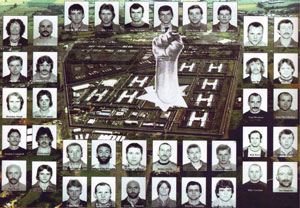25 September 2008 Edition
Remembering the Past

38 IRA prisoners break out of H-Blocks
Less than two years after the end of the 1981 Hunger Strike the British prison, judicial and political systems in Ireland were shaken to the core when 38 IRA prisoners broke out of the H-Blocks of Long Kesh. The September 1983 breakout proved that the British policy of criminalising republican prisoners was well and truly smashed and that republicans were resilient and resourceful.
In a detailed interview in An Phoblacht shortly after the escape, key IRA personnel involved in the breakout stated:
“We perceived the escape as a military operation from beginning to end. It could not have been achieved in any other way, and the ASU – as Volunteers in the Irish Republican Army – were under strict orders throughout from an operations officer whose judgement was crucial and whose every order had to be obeyed.”
Lord Colville, a senior British judicial figure, had to admit:
“One cannot fail to admire the competence of an organisation which enables the prisoners of war to bring to fruition an escape plan which, apart from last-minute calamities, was largely successful.”
The sheer scale and audacity of the breakout caused an immediate sensation but behind the escape was months of detailed planning and preparation. These came to fruition on the afternoon 25 September when IRA prisoners, armed with pistols which had been smuggled into the prison, took over the control area or ‘circle’ of H7-Block. On a given signal the POWs in the four wings of the H-Block overpowered and arrested all the screws. By around 2.45pm the prisoners had complete control of the Block when the screw on duty at the front gate enclosure was arrested.
When the food lorry arrived at H7 it was commandeered and 38 prisoners climbed on board. At gunpoint the driver was ordered to proceed through the security gates in the series of fences which made each H-Block a prison within a prison. At a key ‘tally lodge’ screws were to be held prisoner to allow the food lorry full of POWs to escape without the alarm being raised. The plan became a victim of its own success when more screws than anticipated had to be arrested and eventually the alarm was raised. The lorry had to be abandoned and the prisoners made a run for it out of the compound and across fields. Nineteen were recaptured but 19 got clear away.
As well as those who got away in the escape, the breakout involved other prisoners as back-up in the jail itself and on the outside as well as the many people across Ireland who sheltered the Volunteers.
British Prime Minister Margaret Thatcher was in Canada when the escape happened and she described it as “the gravest in our prison history”. British Direct Ruler Jim Prior said that with “a vast number of life prisoners, all very desperate men, a lot of rotten eggs in one basket, there is always great difficulty in controlling them”.
In contrast to the satisfaction at the escape among people throughout the country, the Fine Gael/Labour Government of Taoiseach Garret FitzGerald and Tánaiste Dick Spring immediately ordered State forces to join with the British in the hunt for the escapees. On the evening of the escape they set up checkpoints along the border. In subsequent years several of the escapees faced extradition from the 26 Counties back into the hands of their jailers.
The escape took place at a time when the British regime was engaged in another ill-fated attempt to break the IRA – this time through the use of paid perjurers. The political background was the electoral success of Sinn Féin in the Assembly elections of 1982, the failure of that Assembly which was boycotted by both Sinn Féin and the SDLP and the Westminster election of June 1983 when Gerry Adams was first elected MP for West Belfast.
The Chief Inspector of the British Prison Service, ‘Sir’ James Hennessy, carried out an official inquiry into the H-Block escape and his report, published in January 1984, stated that it was “not merely audacious and daring, but must be judged the most serious escape in the recent history of the United Kingdom Prison Services”.
Thirty eight IRA prisoners broke out of the H-Blocks on 25 September 1983, 25 years ago this week.
 • THE VAN: The abandoned Long Kesh prison van that got the escapees to the prison gate. “Open up the Long Kesh gate, meals on wheels for 38,” republicans cheered
• THE VAN: The abandoned Long Kesh prison van that got the escapees to the prison gate. “Open up the Long Kesh gate, meals on wheels for 38,” republicans cheered


